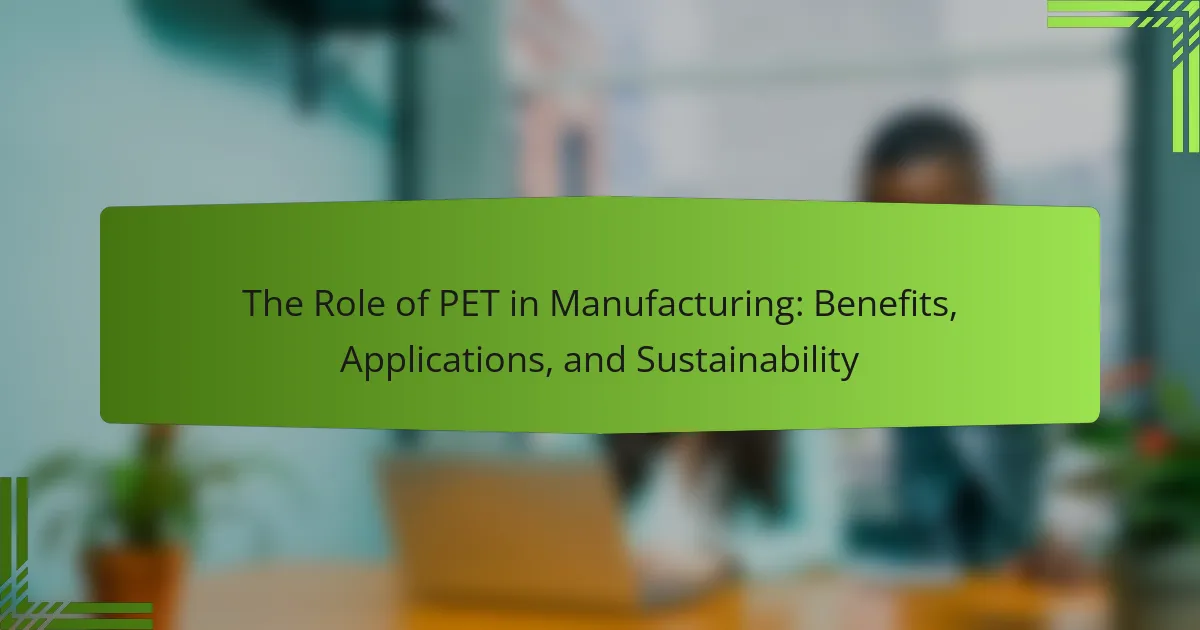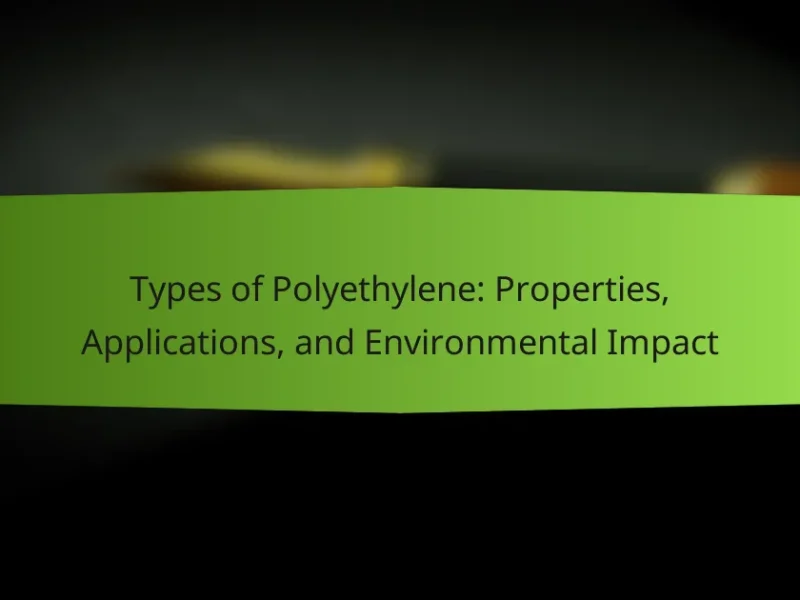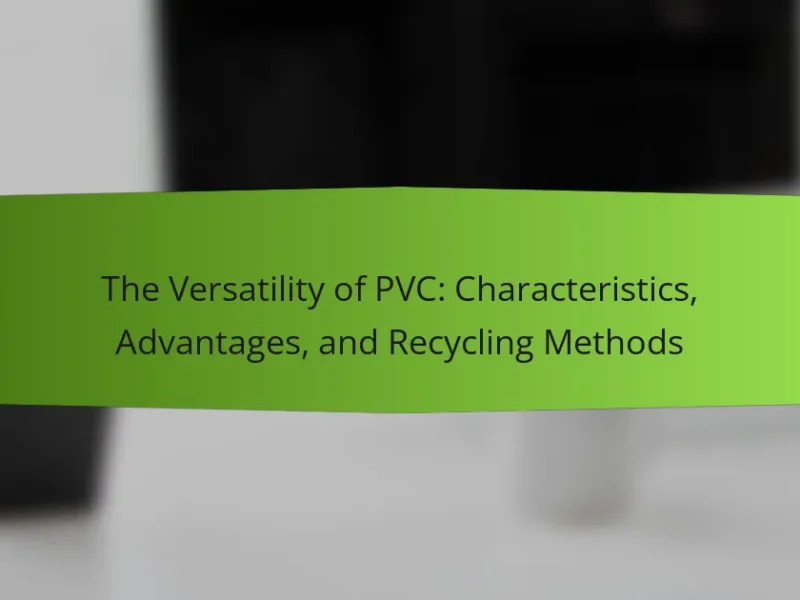Polyethylene terephthalate (PET) is a widely used plastic known for its lightweight, durability, and resistance to moisture and chemicals. This article examines the significance of PET in manufacturing, emphasizing its applications in packaging, textiles, and containers, as well as its recyclability, which supports a circular economy. The global demand for PET reached approximately 30 million metric tons in 2020, with a recycling rate of about 29% for PET bottles. Emerging trends include increased recycling efforts, the development of bio-based PET alternatives, and innovations in production methods aimed at enhancing sustainability and reducing greenhouse gas emissions. Overall, PET plays a crucial role in advancing sustainable manufacturing practices.
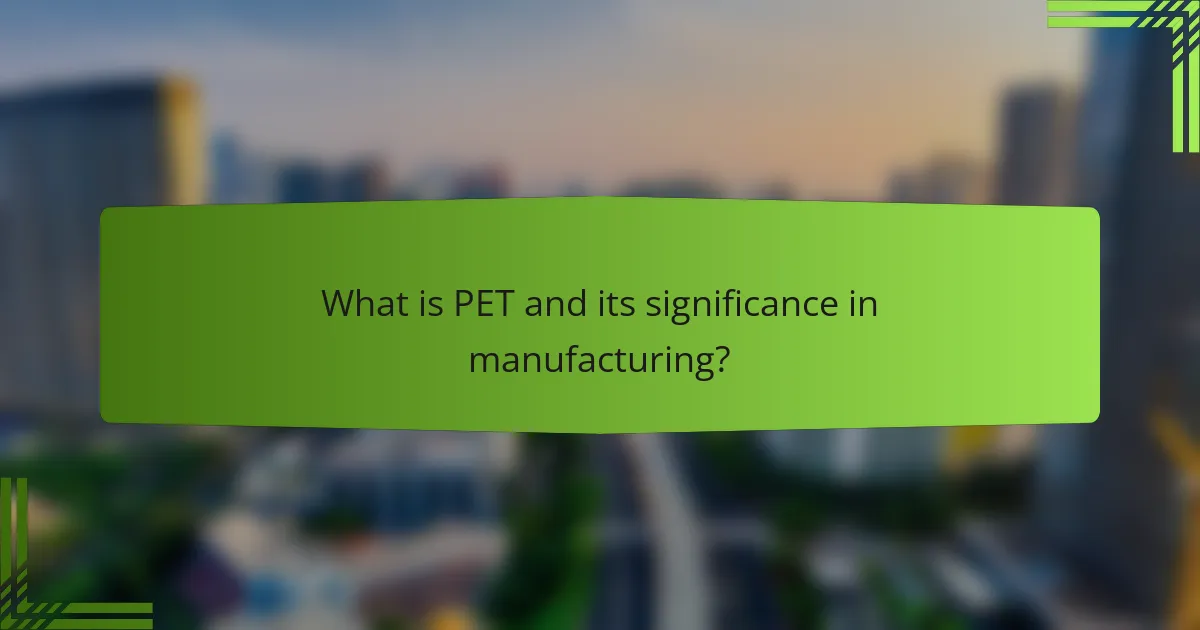
What is PET and its significance in manufacturing?
PET, or polyethylene terephthalate, is a type of plastic commonly used in manufacturing. It is significant due to its lightweight, durability, and resistance to moisture and chemicals. PET is often utilized in packaging, textiles, and containers. In 2020, the global demand for PET reached approximately 30 million metric tons. Its recyclability enhances its importance in sustainable manufacturing practices. PET can be recycled multiple times without losing quality. This characteristic supports a circular economy by reducing waste. Overall, PET’s properties make it a preferred material in various manufacturing sectors.
How is PET produced and processed for manufacturing?
PET, or polyethylene terephthalate, is produced through a polymerization process involving the reaction of terephthalic acid and ethylene glycol. This reaction occurs in a series of steps, starting with the esterification of the two monomers. The resulting intermediate is then subjected to polycondensation, forming long chains of PET.
The production process typically occurs at high temperatures and under vacuum to remove byproducts. The final product is a solid polymer that can be processed into various forms, such as fibers, films, or containers.
Processing of PET for manufacturing involves melting the polymer and shaping it through methods like injection molding or blow molding. These processes allow for the creation of diverse products, from bottles to textiles.
The versatility of PET is supported by its recyclability, which contributes to sustainability in manufacturing. Recycled PET can be reprocessed into new products, reducing waste and resource consumption.
What are the key steps in the PET manufacturing process?
The key steps in the PET manufacturing process include polymerization, crystallization, and extrusion. Polymerization involves the chemical reaction of ethylene glycol and terephthalic acid to form polyethylene terephthalate. This reaction typically occurs in a reactor under specific temperature and pressure conditions.
Next, crystallization occurs to enhance the material’s thermal properties. The PET is cooled and then crystallized to improve its strength and stability.
Finally, extrusion shapes the crystallized PET into pellets, which can be further processed into various products. This step involves melting the PET and forcing it through a die to form the desired shape.
These steps are critical in producing high-quality PET, which is widely used in packaging and textiles.
What are the primary raw materials used in PET production?
The primary raw materials used in PET production are terephthalic acid (TPA) and ethylene glycol (EG). TPA is derived from petroleum and is essential for forming the polyester structure. Ethylene glycol is also sourced from petroleum and plays a crucial role in polymerization. These two materials undergo a chemical reaction to produce polyethylene terephthalate (PET). The combination of TPA and EG results in the formation of long polymer chains, creating the desired properties of PET. PET is widely used in packaging, textiles, and various consumer products due to its strength and durability.
What are the core benefits of using PET in manufacturing?
The core benefits of using PET in manufacturing include its lightweight nature, durability, and recyclability. PET is significantly lighter than glass or metal, which reduces transportation costs. Its strength and resistance to impact make it suitable for various applications. PET can withstand a wide range of temperatures, making it versatile for different environments. Additionally, PET is fully recyclable, promoting sustainability in manufacturing practices. According to the National Association for PET Container Resources, over 1.5 billion pounds of PET were recycled in the U.S. in 2020. This recycling capability supports a circular economy and reduces environmental impact.
How does PET contribute to cost efficiency in production?
PET contributes to cost efficiency in production through its lightweight nature and recyclability. The lightweight aspect reduces transportation costs significantly. This leads to lower fuel consumption and reduced carbon emissions during shipping. Additionally, PET’s recyclability allows manufacturers to reuse materials, decreasing raw material expenses. Studies show that using recycled PET can reduce production costs by up to 30%. Furthermore, PET has a faster production cycle compared to other materials, enhancing overall productivity. This efficiency translates to lower labor costs and increased output. Overall, PET’s properties directly impact cost savings in various stages of production.
What advantages does PET offer in terms of durability and performance?
PET offers significant advantages in durability and performance. It is resistant to impact and shattering, making it ideal for packaging and containers. PET maintains its structural integrity under a wide range of temperatures. This material is also lightweight, which contributes to energy efficiency during transportation. Additionally, PET has excellent barrier properties against moisture and gases. These characteristics help preserve the quality of products within PET containers. Studies show that PET can withstand repeated use, enhancing its longevity. Overall, PET’s durability and performance make it a preferred choice in various manufacturing applications.
In what applications is PET commonly utilized in manufacturing?
PET is commonly utilized in manufacturing for packaging, textiles, and automotive parts. In packaging, PET is used for bottles, containers, and films due to its lightweight and durable properties. The global PET bottle market was valued at approximately $28 billion in 2020, highlighting its significant role in consumer goods. In textiles, PET fibers are used to make clothing and upholstery, providing strength and resistance to wrinkles. The textile industry accounts for a substantial portion of PET consumption, with millions of tons produced annually. In the automotive sector, PET is employed in manufacturing components like dashboards and interior panels, contributing to vehicle weight reduction and fuel efficiency. The versatility of PET makes it a preferred material across these applications.
What are the major industries that rely on PET?
The major industries that rely on PET include packaging, textiles, automotive, and electronics. The packaging industry is the largest consumer of PET, using it for bottles and containers. In textiles, PET is used to produce fibers for clothing and upholstery. The automotive industry utilizes PET for various components due to its lightweight and durable properties. Electronics manufacturers use PET in insulation and protective coatings. According to the European PET Bottle Platform, over 60% of PET production is dedicated to packaging applications.
How is PET used in packaging and consumer goods?
PET is widely used in packaging and consumer goods due to its excellent properties. It is lightweight, durable, and resistant to impact. These characteristics make it ideal for containers, bottles, and food packaging. PET is also transparent, allowing consumers to see the product inside. This transparency enhances product appeal and marketing. Additionally, PET is recyclable, promoting sustainability in packaging solutions. According to the National Association for PET Container Resources, over 1.5 million tons of PET were recycled in the U.S. in 2020. This recycling capability supports environmental initiatives and reduces waste. Overall, PET’s versatility and sustainability make it a preferred choice in the packaging industry.
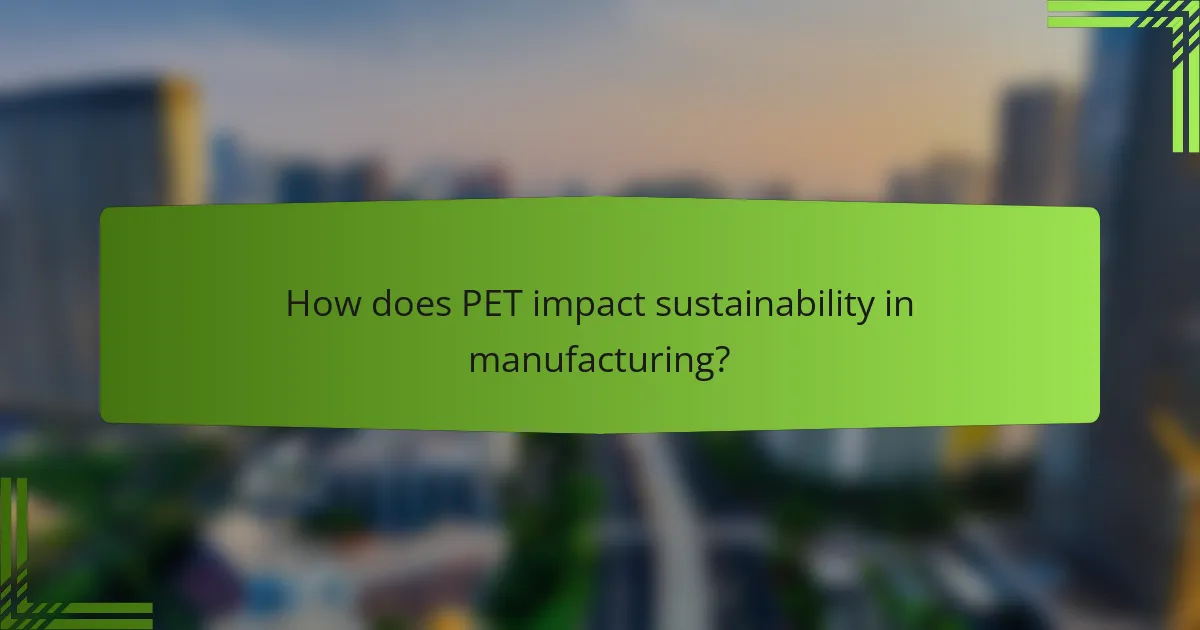
How does PET impact sustainability in manufacturing?
PET, or polyethylene terephthalate, significantly impacts sustainability in manufacturing. It is widely recyclable, promoting a circular economy. The recycling rate of PET bottles reached approximately 29% in 2020, according to the National Association for PET Container Resources. This reduces the need for virgin plastic production. Additionally, using recycled PET (rPET) in manufacturing lowers greenhouse gas emissions by up to 79% compared to new PET production, as reported by the Carbon Trust. PET’s lightweight nature also contributes to energy savings during transportation. Thus, PET enhances sustainability through recyclability, reduced emissions, and energy efficiency.
What are the environmental benefits of using PET?
PET, or polyethylene terephthalate, offers significant environmental benefits. It is highly recyclable, with about 30% of PET bottles being recycled globally. Recycling PET reduces the need for virgin materials, thus conserving resources. Additionally, using recycled PET requires 75% less energy compared to producing new PET. This energy savings translates to lower greenhouse gas emissions. Furthermore, PET has a lightweight nature, which decreases transportation emissions. Its durability extends product lifespan, reducing waste. Overall, PET contributes positively to environmental sustainability through its recyclability and energy efficiency.
How does PET recycling contribute to sustainability efforts?
PET recycling significantly contributes to sustainability efforts by reducing plastic waste and conserving resources. Recycling PET can save up to 84% of the energy required to produce new PET from raw materials. This process also reduces greenhouse gas emissions by approximately 71% compared to producing virgin PET.
Additionally, recycling PET diverts waste from landfills, where it can take hundreds of years to decompose. In 2020, about 1.8 million tons of PET were recycled in the U.S., showcasing the potential for increased recycling rates. Moreover, recycled PET can be repurposed into new products, such as clothing and containers, promoting a circular economy. Thus, PET recycling plays a crucial role in enhancing environmental sustainability.
What initiatives exist to promote sustainable PET production?
Initiatives to promote sustainable PET production include the Global PET Recycling Alliance and the Ellen MacArthur Foundation’s New Plastics Economy initiative. The Global PET Recycling Alliance focuses on increasing the recycling rates of PET through collaboration among industry stakeholders. It aims to create a circular economy for PET by ensuring that recycled PET is used in new products. The Ellen MacArthur Foundation promotes sustainable practices by encouraging companies to design products for recyclability and to invest in recycling technologies. These initiatives help reduce plastic waste and improve the sustainability of PET production.
What challenges are associated with PET in manufacturing?
Challenges associated with PET in manufacturing include high energy consumption and environmental concerns. The production process of PET requires significant energy, leading to increased operational costs. Additionally, the reliance on fossil fuels for production contributes to greenhouse gas emissions. Recycling PET is often complicated due to contamination and sorting issues. The mechanical properties of recycled PET may not match those of virgin material, limiting its usability. Furthermore, the increasing demand for sustainable practices pressures manufacturers to innovate. Compliance with stringent regulations on plastic waste adds complexity to manufacturing processes.
What are the limitations of PET as a material?
PET has several limitations as a material. It is susceptible to hydrolysis, which can weaken its structure when exposed to moisture. PET also has a relatively low melting point, around 260°C, limiting its use in high-temperature applications. Additionally, it can become brittle over time when exposed to UV light. This brittleness affects its durability and lifespan. PET is also not biodegradable, leading to environmental concerns regarding plastic waste. Furthermore, it can absorb odors and flavors, making it less suitable for certain food packaging. These limitations impact its versatility in various manufacturing applications.
How can manufacturers address the challenges of PET waste?
Manufacturers can address the challenges of PET waste through recycling initiatives and sustainable practices. Implementing closed-loop recycling systems allows manufacturers to reuse PET materials. This reduces the need for virgin materials and minimizes waste. Additionally, investing in advanced recycling technologies can enhance the efficiency of PET recycling processes. For instance, chemical recycling can convert PET back into its original monomers. This method has the potential to recycle up to 90% of PET waste. Collaborating with waste management companies can also improve collection and sorting of PET materials. Furthermore, manufacturers can educate consumers about proper disposal and recycling of PET products. These strategies collectively contribute to a significant reduction in PET waste.
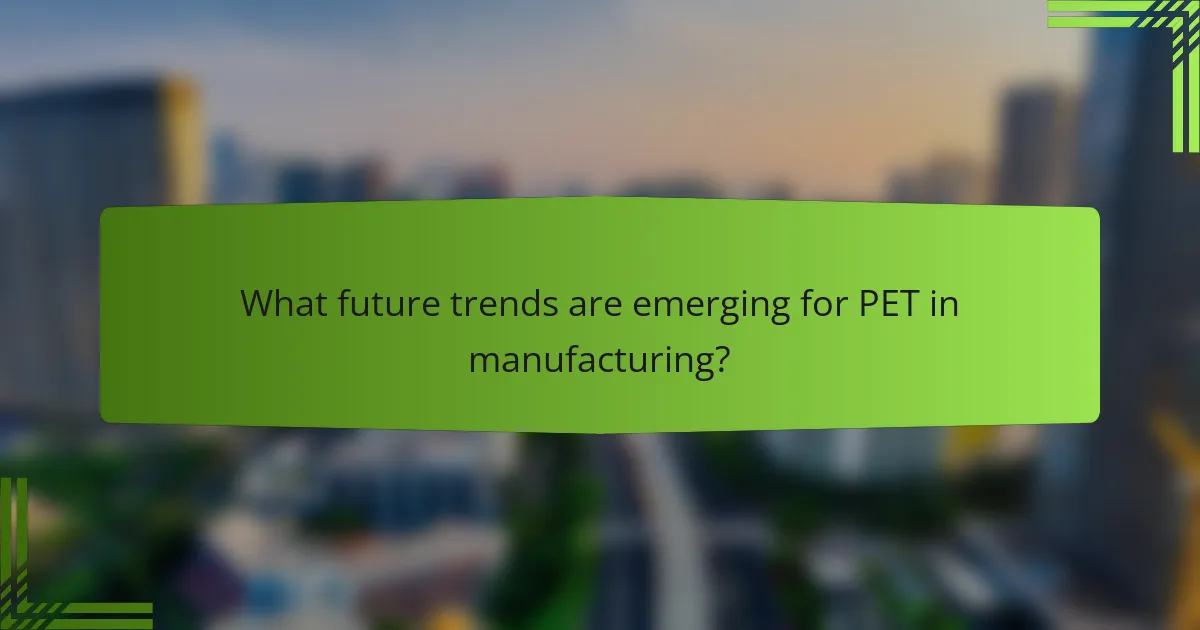
What future trends are emerging for PET in manufacturing?
Emerging trends for PET in manufacturing include increased recycling efforts and the development of bio-based PET alternatives. The focus on sustainability drives manufacturers to improve recycling technologies. Innovations like chemical recycling enable more efficient processing of PET waste. Additionally, advancements in bioengineering are leading to the creation of plant-based PET. This shift aims to reduce reliance on fossil fuels. Enhanced production methods are also being explored to lower energy consumption. Furthermore, the demand for lightweight materials is pushing the development of stronger, thinner PET products. These trends indicate a significant transformation in the PET manufacturing landscape.
How is technology advancing PET manufacturing processes?
Technology is advancing PET manufacturing processes through automation, improved recycling methods, and enhanced production efficiency. Automation increases precision and reduces labor costs. Advanced robotics streamline assembly lines, allowing for higher output rates. Improved recycling methods utilize enzymatic processes to break down PET into its basic components. This innovation enables more effective recycling and reduces waste. Enhanced production efficiency is achieved through the use of advanced materials and energy-efficient machinery. For instance, newer machines consume less energy while maintaining high production standards. These advancements collectively contribute to more sustainable PET manufacturing practices.
What innovations are being developed to enhance PET sustainability?
Innovations to enhance PET sustainability include the development of biodegradable PET alternatives. Companies are researching bio-based materials that can replace traditional PET. These materials aim to reduce reliance on fossil fuels. Advanced recycling technologies are also being implemented. These technologies enable the recycling of PET into high-quality products. Chemical recycling processes can break down PET into its original monomers. This allows for infinite recyclability without quality loss. Additionally, the use of enzymes to decompose PET is being explored. This method could potentially accelerate the recycling process. Overall, these innovations are critical for reducing environmental impact.
What best practices should manufacturers follow when using PET?
Manufacturers should follow several best practices when using PET. First, they must ensure proper material selection based on the intended application. This includes assessing the required mechanical properties and thermal stability of PET. Second, manufacturers should implement effective processing conditions. Optimal temperature and pressure settings are crucial for achieving desired product quality. Third, they need to prioritize recycling and sustainability. Incorporating recycled PET can reduce environmental impact and promote circular economy principles. Fourth, manufacturers should conduct thorough quality control. Regular testing of PET products ensures compliance with industry standards. Lastly, they must stay updated on regulations. Adhering to local and international guidelines is essential for safe PET usage. Following these practices enhances the efficiency and sustainability of PET manufacturing.
How can companies improve PET recycling rates in their operations?
Companies can improve PET recycling rates by implementing effective collection and sorting systems. Enhanced sorting technologies can increase the purity of recycled PET. Education campaigns can raise awareness among consumers about proper recycling practices. Partnerships with recycling facilities can streamline the recycling process. Additionally, companies can invest in closed-loop recycling systems to reuse PET in their operations. According to the National Association for PET Container Resources, recycling rates for PET containers reached 29.1% in 2020, indicating potential for growth. Companies adopting these strategies can contribute to higher recycling rates and improved sustainability outcomes.
What strategies can be employed to minimize PET waste in manufacturing?
Implementing recycling programs is a key strategy to minimize PET waste in manufacturing. These programs facilitate the collection and processing of used PET materials. Manufacturers can also adopt closed-loop systems to reuse PET waste in their production processes. This reduces the need for virgin materials and conserves resources.
Optimizing production processes can further decrease waste generation. Techniques such as lean manufacturing minimize excess material and improve efficiency. Regular maintenance of machinery ensures optimal performance, reducing defects and waste.
Training employees on waste reduction practices enhances awareness and responsibility. Educating staff about the importance of minimizing PET waste can lead to more conscientious behavior.
Collaboration with suppliers and customers can also drive waste reduction initiatives. By working together, stakeholders can identify opportunities for reducing PET usage throughout the supply chain.
According to the National Association for PET Container Resources, recycling PET can save up to 75% of the energy required to produce new PET. This statistic underscores the importance of these strategies in promoting sustainability in manufacturing.
The primary entity of this article is polyethylene terephthalate (PET), a widely used plastic in manufacturing. The article explores PET’s significance due to its lightweight, durability, and recyclability, highlighting its applications in packaging, textiles, and automotive parts. Key aspects of PET production, including polymerization and processing methods, are discussed, along with its environmental benefits and contributions to sustainability. The article also addresses challenges in PET manufacturing, emerging trends, and best practices for improving recycling rates and minimizing waste.
